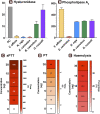Stings on wings: Proteotranscriptomic and biochemical profiling of the lesser banded hornet (Vespa affinis) venom
- PMID: 36601583
- PMCID: PMC9806352
- DOI: 10.3389/fmolb.2022.1066793
Stings on wings: Proteotranscriptomic and biochemical profiling of the lesser banded hornet (Vespa affinis) venom
Abstract
Distinct animal lineages have convergently recruited venoms as weaponry for prey capture, anti-predator defence, conspecific competition, or a combination thereof. Most studies, however, have been primarily confined to a narrow taxonomic breadth. The venoms of cone snails, snakes, spiders and scorpions remain particularly well-investigated. Much less explored are the venoms of wasps (Order: Hymenoptera) that are infamous for causing excruciating and throbbing pain, justifying their apex position on Schmidt's pain index, including some that are rated four on four. For example, the lesser banded wasp (V. affinis) is clinically important yet has only been the subject of a few studies, despite being commonly found across tropical and subtropical Asia. Stings from these wasps, especially from multiple individuals of a nest, often lead to clinically severe manifestations, including mastocytosis, myasthenia gravis, optic neuropathy, and life-threatening pathologies such as myocardial infarction and organ failure. However, their venom composition and activity remain unexplored in the Indian subcontinent. Here, we report the proteomic composition, transcriptomic profile, and biochemical and pharmacological activities of V. affinis venom from southern India. Our findings suggest that wasp venoms are rich in diverse toxins that facilitate antipredator defence. Biochemical and pharmacological assessments reveal that these toxins can exhibit significantly higher activities than their homologues in medically important snakes. Their ability to exert potent effects on diverse molecular targets makes them a treasure trove for discovering life-saving therapeutics. Fascinatingly, wasp venoms, being evolutionarily ancient, exhibit a greater degree of compositional and sequence conservation across very distant populations/species, which contrasts with the patterns of venom evolution observed in evolutionarily younger lineages, such as advanced snakes and cone snails.
Keywords: V. affinis; arthropod venom; venom gland transcriptome; venom proteome; wasp venom.
Copyright © 2022 Sunagar, Khochare, Jaglan, Senthil and Suranse.
Conflict of interest statement
The authors declare that the research was conducted in the absence of any commercial or financial relationships that could be construed as a potential conflict of interest.
Figures




Similar articles
-
Comparative proteomic analysis of two wasps venom, Vespa tropica and Vespa affinis.Toxicon. 2016 Sep 1;119:159-67. doi: 10.1016/j.toxicon.2016.06.005. Epub 2016 Jun 8. Toxicon. 2016. PMID: 27288895
-
Proteome and allergenome of Asian wasp, Vespa affinis, venom and IgE reactivity of the venom components.J Proteome Res. 2014 Mar 7;13(3):1336-44. doi: 10.1021/pr4009139. Epub 2014 Feb 4. J Proteome Res. 2014. PMID: 24437991
-
The deep-rooted origin of disulfide-rich spider venom toxins.Elife. 2023 Feb 9;12:e83761. doi: 10.7554/eLife.83761. Elife. 2023. PMID: 36757362 Free PMC article.
-
Wings and stings: Hymenoptera on vacation.Ann Allergy Asthma Immunol. 2023 Apr;130(4):429-437. doi: 10.1016/j.anai.2023.01.017. Epub 2023 Jan 23. Ann Allergy Asthma Immunol. 2023. PMID: 36702244 Review.
-
Venomous snakes of Costa Rica: biological and medical implications of their venom proteomic profiles analyzed through the strategy of snake venomics.J Proteomics. 2014 Jun 13;105:323-39. doi: 10.1016/j.jprot.2014.02.020. Epub 2014 Feb 24. J Proteomics. 2014. PMID: 24576642 Review.
Cited by
-
Being Stung Once or Twice by Bees (Apis mellifera L.) Slightly Disturbed the Serum Metabolome of SD Rats to a Similar Extent.Int J Mol Sci. 2024 Jun 8;25(12):6365. doi: 10.3390/ijms25126365. Int J Mol Sci. 2024. PMID: 38928075 Free PMC article.
References
-
- Andrews S. (2010). “FastQC: A quality control tool for high throughput sequence data,” in Babraham bioinformatics (Cambridge, United Kingdom: Babraham Institute; ).
LinkOut - more resources
Full Text Sources
Molecular Biology Databases
Miscellaneous

